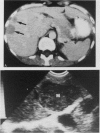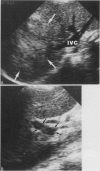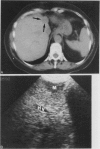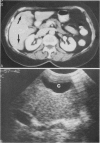Abstract
The surgeon operating upon patients with primary or metastatic hepatic cancers must determine if resection is feasible and, if it is, the magnitude of required resection. In an attempt to determine which tests best aid the surgeon in these determinations, the authors prospectively compared preoperative computed tomography (CT) of the liver and intraoperative ultrasound (IOU) in 42 patients with liver tumors who underwent 45 exploratory operations. The primary diseases included colorectal cancer metastases in 27 patients, hepatoma in 11 patients, and metastatic cancers of other origins in 4 patients. In the 42 patients there were 89 identified hepatic lesions that were confirmed to be malignant by resection, biopsy, or continued growth on follow-up CT. The sensitivity of either test for detecting these lesions was 69/89 (77%) for CT and 87/89 (98%) for IOU. Resection was not feasible in 13 patients. Five had extrahepatic disease, 4 had more nodules discovered by IOU, 3 were found by IOU to have involvement of all three hepatic veins by tumor and 1 patient had portal-vein invasion. Alternatively, in four patients tumors thought to involve all three hepatic veins by CT were shown to be free of at least one hepatic vein, thereby permitting resection. In one patient who had been previously operated upon, a tumor thought to involve the remaining right hepatic vein was seen to be free of the vein, also permitting resection. Regarding the extent of resection, IOU was also helpful. Lesser procedures than anticipated were proved possible by IOU in seven patients. A more extensive resection was shown to be necessary by IOU in two patients. Thus, IOU affected the operative management in 22 of 45 operative episodes (49%). It was conclude that IOU is superior to both preoperative CT and surgical exploration in assessing both the feasibility and the extent of resection required for primary and secondary hepatic cancers. In the authors' experience, IOU is the most sensitive indicator of number of lesions present in the liver. In addition, the ability of IOU to determine hepatic venous anatomy is a helpful adjunct in determining resectability of liver tumors.
Full text
PDF







Images in this article
Selected References
These references are in PubMed. This may not be the complete list of references from this article.
- Adson M. A. Resection of liver metastases--when is it worthwhile? World J Surg. 1987 Aug;11(4):511–520. doi: 10.1007/BF01655817. [DOI] [PubMed] [Google Scholar]
- Bismuth H., Castaing D., Garden O. J. The use of operative ultrasound in surgery of primary liver tumors. World J Surg. 1987 Oct;11(5):610–614. doi: 10.1007/BF01655836. [DOI] [PubMed] [Google Scholar]
- Machi J., Isomoto H., Yamashita Y., Kurohiji T., Shirouzu K., Kakegawa T. Intraoperative ultrasonography in screening for liver metastases from colorectal cancer: comparative accuracy with traditional procedures. Surgery. 1987 Jun;101(6):678–684. [PubMed] [Google Scholar]
- Makuuchi M., Hasegawa H., Yamazaki S., Takayasu K., Moriyama N. The use of operative ultrasound as an aid to liver resection in patients with hepatocellular carcinoma. World J Surg. 1987 Oct;11(5):615–621. doi: 10.1007/BF01655837. [DOI] [PubMed] [Google Scholar]
- Rifkin M. D., Rosato F. E., Branch H. M., Foster J., Yang S. L., Barbot D. J., Marks G. J. Intraoperative ultrasound of the liver. An important adjunctive tool for decision making in the operating room. Ann Surg. 1987 May;205(5):466–472. doi: 10.1097/00000658-198705000-00004. [DOI] [PMC free article] [PubMed] [Google Scholar]







